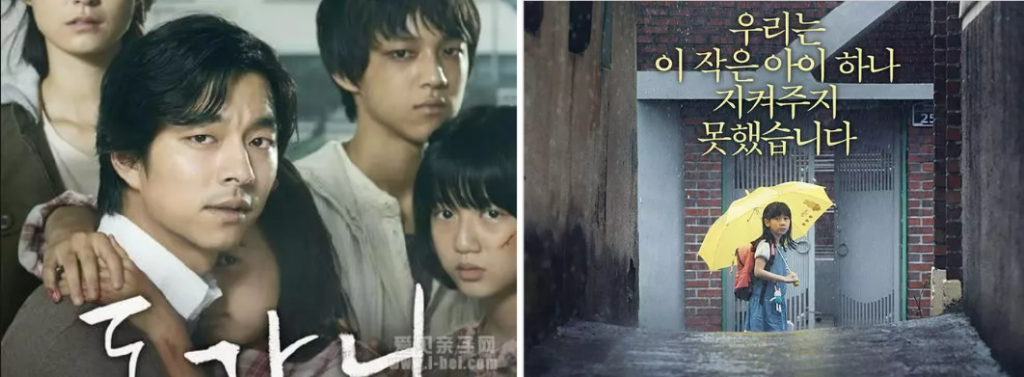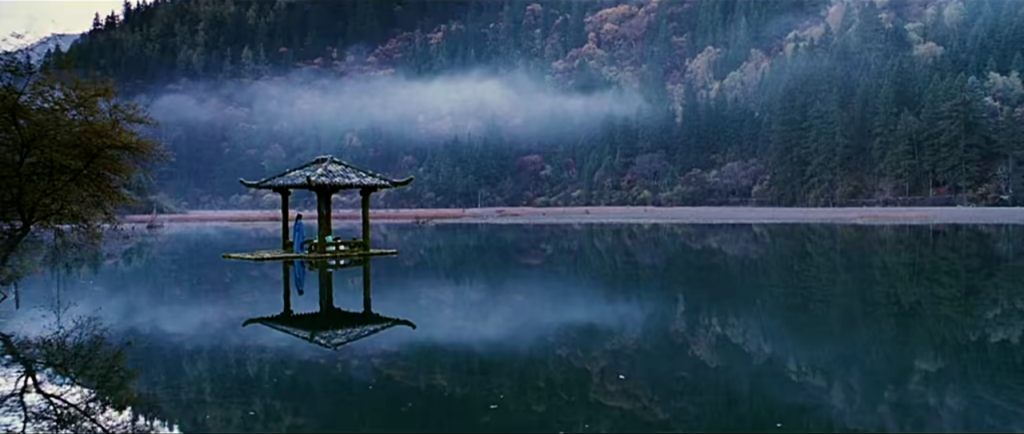Hope & Silence 2023/1/18

Hope is the second Korean film about child sexual abuse I have seen after Silence. Although these two movies are in the same genre and both are movies based on actual events, their styles are distinctly different.
Firstly, the whole colour tones of the two are drastically different. The overall style of Hope is bright and warm, while Silence’s overall tone is cold and gloomy.
When comparing the opening scenes of the two films, Hope is a white kite floating in the blue sky and clouds, while Silence starts with a train driving in the dark and foggy night. The tone of the beginning of the work predetermines the two films’ very distinctive styles and directions.
First, both movies are full of metaphors for the movie’s direction at the beginning.
In Hope, the white kite flying in the sky is Suyuan, and at first, it flies freely in the sky. But on a rainy day, it falls on the road, where the rain and mud make it no longer clean and pure. Then it was picked up by a criminal. This is a metaphor that Hope was abused and hurt by this criminal.


In Silence, the train travelling in the darkness and fog at the beginning is like the hero. Despite having only a faint light, all those who pursue justice and truth are still determined to travel through the fog and the unknown and do not give up even though the darkness and fog bury the truth.

Secondly, while both films depict child sexual abuse, Hope skips the details of the sexual abuse and goes straight from the child’s abduction by the perpetrator to Suyuan ‘s dying state. The film’s tone is not destined to be depressing or sad; Hope focuses on Suyuan ‘s family and close friends supporting each other and healing after her abuse, while Silence has plenty of sexual abuse and child maltreatment sequences. Although the movie has a happy ending as well, the film focuses on exposing the corruption and incompetence of the Korean police force and the darkness and cruelty behind the power.


After watching these two films, I am deeply aware that films on the same subject can be so different. Producers can use tone, scene, and plot to convey exactly what they want to show to the audience according to the theme and core of the film. If Silence is a voice for justice, Hope should be a warm light to heal the trauma.
My sister

I’ve been looking forward to this movie since I heard it existed, and I want to see it.
Overall, the movie made me feel depressed yet healed. From the car accident scene at the beginning to the siblings hugging each other at the end and the sister crying out in pain. I don’t think I’ve ever watched a movie where I cried almost from start to finish and had a headache from crying at the end. I was moved by almost every image and line in this movie.
Although I have a younger brother, my story differs from this movie. I was lucky not to live in a patriarchal era, a patriarchal family. Our relationship is equal. Nonetheless, I found an inexplicable resonance in this movie, as if I was An Ran at that moment, and sister Zi Feng brought the character to life. In those moments, it was as if I could relate to what An Ran was thinking, not Zhang Zi Feng.

The topic this movie wants to convey is profound, heavy, and eager to be seen by more people. How many women are affected by the concept of patriarchy, and how many good women have had their lives cut short because of this concept, which could have been bright and magnificent? They may be like Enron, who is not resigned to her fate, does not give in, fights for the future she wants, and does not care about the eyes of others. But I think perhaps more like Anran’s aunt, resigned to her fate, paving the way for the future of her male peers at home with her own sacrifice, perhaps with resignation, but with no choice. It is undeniable how difficult it is for a person to go against the tide and how much inner fortitude and tenacity are needed.
Each character in this movie has a complete story, allowing me to be genuinely submerged in this storyline. There is no absolute good or bad; everyone carries a different burden, and they all do what they must do. The lines, images, character expressions, and scenes in the story seem just right. I think good work should be like this; it doesn’t need to be grand or magnificent. It’s enough to touch the heart and move it. So I have to say, I think my sister is the most three-dimensional, complete and moving work I’ve seen in recent years.
I hope there will be more such good works in the future, and I hope that no one will be born a sister, no one will be born a brother. Everyone deserves to be treated fairly and to be loved relatively. After all, “life is too short, and everyone is busy.”
The Father

My initial impression of the film was only of the fantastic performance of Anthony Hopkins in “Silence of the Lambs” and the shallow understanding of “Alzheimer’s”. So I didn’t have time to imagine how the film would unfold.
I didn’t particularly understand what was happening in the film’s first half. Still, as the film progressed, I felt a deep sense of empathy as I understood that it was shot from the perspective of an elderly man with Alzheimer’s. I felt his fear, disbelief and confusion. This perspective allowed me to immerse myself in the old man, the father, and see him as a distinct and independent individual, a fascinating person while afflicted by the disease. And while describing this old man’s perspective, it also describes the daughter’s personal feelings and the story’s background so clearly that I could see the changes in their relationship with each other as they gradually forget.

Three things struck me. The first detail is that when the father, played by the male lead, tucked the unused plastic bag into his pocket in the kitchen, it reminded me of my grandparents. This small detail made it seem like the male lead from far away on the big screen jumped directly at me as if I knew such an old man.
The second point is the conflict between the father’s point of view and his son-in-law, “How long are you going to be a burden to the people around you” as well as the old man’s repeated emphasis on how well he can take care of himself, and his daughter’s concern for her father. These multi-perspective details allow me to look at the matter of “supporting the elderly” from multiple standpoints, and even many “unreal” expressions in the film made me want to think about how people should handle these relationships and the problems they face when they grow old.
Finally, near the end of the film, the overall “summary”. As my father’s symptoms worsened, it made me realize that the points I had previously felt “puzzled” by were the world my father saw, and it also made me feel what my life might be like as an elderly man with Alzheimer’s. I would have trouble remembering time and the past. I can’t remember a time, I can’t remember what happened in the past or the present, I can’t remember the important people around me, I can’t remember what happened. So I need to be taken care of and loved.
Finally, I have to say that Anthony Hopkins Sr.’s acting is just superb! As well as each of the characters in the movie, I was able to have a deep sense of empathy. While being moved, I also hope there will be a cure for Alzheimer’s disease so that love is not forgotten.

After the second viewing, I found some details that I overlooked on the first viewing. For example, there are many doors in the story, and sometimes even several doors in one scene. I think that the door means “trapped”, just like the name of the movie trapped in time father. They are trapped there. And it seems that the presence of doors sometimes reduces my sense of concern for the people near them, making them more vulnerable. As well as in the first half of the movie, why the protagonist will go to the table, it feels like there is an allegory of a forgotten time.
And on the time and space scenes that I felt confused about the first time I saw them, I found some ideas in general, although I was still a little confused. I saw the confusing characters, space and time because the director showed the main character’s viewpoint, an old man with Alzheimer’s disease, to the audience, so most of the time, I was following the real feelings of the old man to experience the development of the story. As an old man with Alzheimer’s, my sense of the environment around me was confused. I couldn’t remember the time, or even the appearance of the people around me, which is why the faces of the caregivers and doctors became the faces of my daughter and her husband, and the scenes were mixed in my daughter’s apartment, the old man’s apartment and the nursing home. And in the middle of some stories, for space scenes of the empty mirror, the director should also want to give the audience a hint of the time change.
In addition to these, the film’s theme also made me feel a lot. If someday in the future, I also suffer from Alzheimer’s disease, have no concept of time, mixed up space, can not remember what happened, and even can not remember the appearance of people close to me, whether it is like the film brought me the same sense of confusion and helplessness, that kind of sadness. And it’s not just limited to the helplessness of the patients themselves, but also whether the people close to the patients feel very helpless and painful. It also made me understand more about Alzheimer’s patients as a group and even see what is happening in the world from their perspective in a new way.
Hero

As the first movie I watched in this semester’s film class, it’s a movie that’s worth watching again and again.
First, the film’s picture, colour scheme, and soundtrack are beautiful and give people a feeling of being there. It will let me enjoy and immerse myself in the movie, especially the soundtrack, which is very good and evocative.
This movie was seen as a child; I still remember that I only thought the picture of this movie was very nice but did not see what the movie was about, why people wore different clothes in each paragraph, or what the truth is in the end. But after watching and listening to some of Strawberry’s analysis this time, I realized that this movie turned out to be so subtle.

The director’s use of colour not only divides the story section and makes it easier for the audience to understand the story’s development, but also, the different colours represent the tone of the different sections. In the first version of the story of Nameless, its primary colour is red. Different reds in the story represent different meanings, such as the suspicion of suspicion between the remnant sword and flying snow, as well as the jealousy between the three relationships, the passion of emotions, etc., and the kind of fierce and unyielding spirit of the people of Zhao before the disaster. And in the conjecture of the King of Qin, the green-blue colour is used as the leading tone to express a sense of rationality and innocence. In the final true story, black and white are the primary colours. Overall, the use of colour not only delineates the story’s vein but also expresses different emotions in the story.
Finally, I was also struck by this viewpoint on the hero’s expression. Because maybe my own bias has led me not to have a good feeling about Qin Shi Huang, but it feels like the Qin Shi Huang in the story is a little different from what I imagined. But the director did not deliberately try to embellish the image of Qin Shi Huang, but rather, based on the history of the situation, to develop the imagination space, so this also impressed me.
Parasites

The parasite is a movie that made me feel the difference between the classes in Korea, and the director made me feel the difference even more through the precise design of various costumes. There are a lot of visualizations of class in the film, such as the introduction of the poor family’s living environment at the beginning, the many stairs in the rich man’s house, and the family’s return to their place from top to bottom in the middle of the night after going downstream in the heavy rain, as well as many shots moving from top to bottom and bottom to top. I feel that the part that impressed me the most is the part of the poor family going step by step to get a career; the overall rhythm of the film, layer by layer, until the housekeeper’s aunt “under the hair” and the use of music to make the rhythm of the climax, watching cool.
In addition, the film made me even think about whether such a situation would happen. Or maybe the movie reflects reality, and even reality is crueller than the movie. I can’t criticize the good and bad of the poor and the rich in the movie, and I may be “disgusted” by the way they strut around and enjoy the life of the rich in the movie, but if I were in that situation, what would I do, I don’t have an answer.
However, while watching the film, I also found it difficult to watch the film from a production point of view, not only because I had not seen the film in full beforehand but also because I felt that the director was too fine in the process of making the film, with every detail just right so that I naturally forgot what I was doing. They were all arranged in a natural combination, giving me an excellent viewing experience. So if I want to exercise this kind of producer’s perspective on a film, I should still spend a lot of time honing it.
Home Sweet Home

Overall, its graphics and various decorations did make me feel like I was watching a Korean movie, even a bit like Parasite (although I haven’t seen the full version of Parasite, it gave me a similar feeling). But before I saw the movie, I had a particular bias. Because I saw many complaints about the movie being wrong, I might have had a preconceived idea. After watching it, I think the overall plot is a bit strange, but this does not affect the movie picture brings me a pleasant feeling. The movie has a lot of close-ups, and there are many shots of the items in the house on display. For example, fingerprint locks, many paintings and so on. The movie’s overall tone is rather dark, and there seem to be few bright colours. And most of the people in the house are dressed in black and white, as well as their home revolving staircase, especially like the black and white keys of their home piano. But the heroine will be different. She has different coloured clothes, she likes to paint, and her paintings contain many plants. It feels like these characteristics express the heroine is destined, and the family atmosphere does not fit the feeling. She aspires to life rather than the dead atmosphere of the home.
Overall, the film gave me the feeling of dead beauty. Whether it is the home furnishings or a variety of lighting settings, they are very good for setting the atmosphere.

